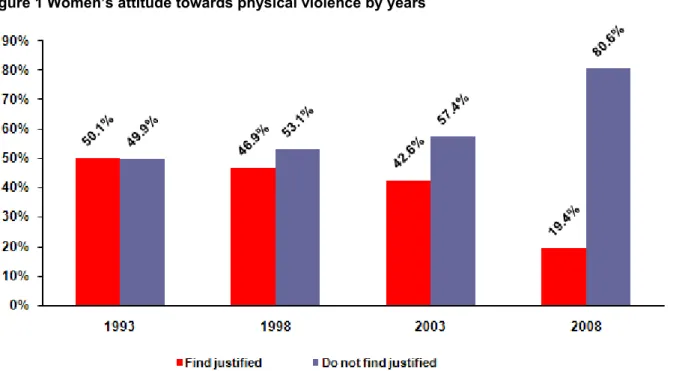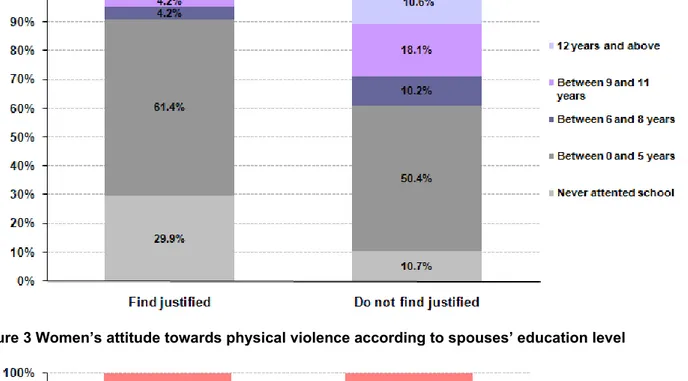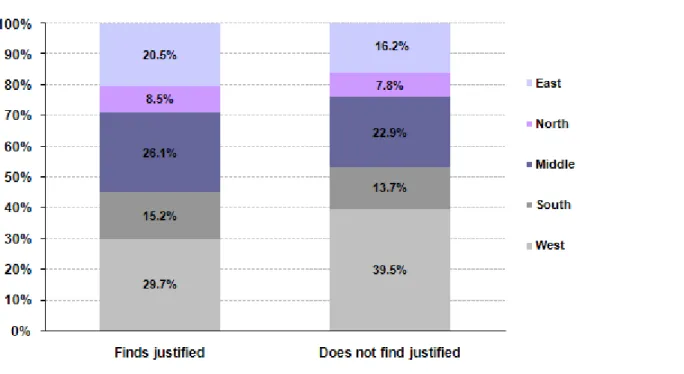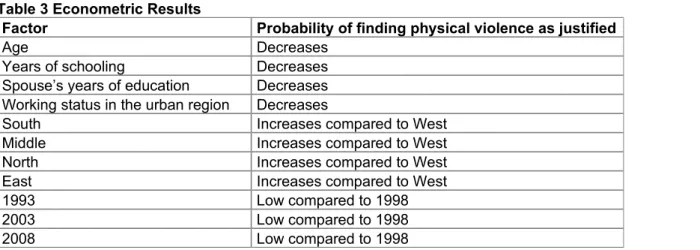WORKING SAVES WOMEN’S LIVES
Gökçe Uysal ve Hande Paker
Executive Summary
Despite sustained efforts in Turkey for many years, violence against women persists. Studies on violence against women reveal that women’s perception about and their attitude towards violence appears to be an important factor regarding the issue. In this research note, the relationship between women’s attitude towards domestic violence and their employment status is analyzed. Even if factors like women’s own education levels, spouse’s education levels, and their regions of residence are taken into account, working women are less likely to find physical violence justified. In other words, being employed is important in being able to stop the potential abuse in a woman’s life. The relationship between women’s perception on violence and employment reveals that encouraging women’s labor force participation is an important component in preventing violence against women.
Violence against Women in Turkey
One of the most important dimensions of gender inequality in Turkey is the prevalence of violence against women. In Turkey, 39 percent of women noted that they have experienced physical violence.1 Despite the work carried out by the women’s movement and women’s rights organizations in this field for over 30 years, increased social awareness and importance given to the issue by the public sector, violence against women could not be reduced. Since the eradication of violence against women depends first and foremost on designing efficient policies, it is obvious that determining the causes of violence is important.
Studies demonstrate that women’s attitude towards violence has an important role in taking action against violence. For example, the most recent and comprehensive research2 on domestic violence against women in Turkey reveals that victims do not report to women’s organizations and institutions which could support them and prevent future attacks. The most important reason is that women do not define the violence they experience as a serious problem; in other words, violence is normalized. In this context, women’s attitude towards violence is one the most important components of creating efficient policies to prevent domestic violence. In this research note, women’s perception of violence is measured by their status of justification of domestic violence. 3
Another dimension of gender inequality that we considered is the labor force participation of women. In 2011, female employment in Turkey remains as low as 24.8 percent in urban areas. This research note explores the relationship between women’s perception towards violence, and their labor force participation. In this context, we study whether women’s status of justification of domestic violence is related to their employment status.
Data Set
Hacettepe University Institute of Population Studies conducts the Turkey Demographic and Health Survey every five years on a nationally representative sample of ever-married women between the ages of 15 and 49. The survey collects data on socioeconomic status, fertility history and opinions. In this research note, we use data for the years DHS 1993, 1998, 2003 and 2008 waves, representing a total of 30 thousand 575 women. 4
Assist. Prof. Gökçe Uysal, Betam, Vice Director, gokce.uysal @bahcesehir.edu.tr
Assist. Prof. Hande Paker, Bahcesehir University FEAS Academic Staff, hande.paker@bahcesehir.edu.tr
1Jansen, H., S. Üner, and F. Kardam. 2009. National Research on Domestic Violence against Women in Turkey. Ankara. 2Jansen, H., S. Üner, and F. Kardam. 2009. National Research on Domestic Violence against Women in Turkey. Ankara.
3The important point in here is women’s perception about violence and experiencing violence are two different things. The ratios noted
in this research are about women’s perceptions and are different from the ratios of women experiencing violence.
46519 women in 1993, 8579 women in 1998, 8075 women in 2003 and 7405 women in 2008 responded to the surveys.
Research Brief 12/129
The women were asked whether they thought physical violence by the spouse was right or justified under certain conditions. These conditions were provided by the survey and unfortunately they change every year. Table 1 provides these conditions for different years for which data was available. In 2003, the question asked whether the woman thought a husband had a right to beat his wife. In 2008, the question asked whether physical violence by the spouse is justified.5
Table 1 Cases when domestic violence is justified
2008 2003 1998 1993
When woman does not cook x X x
When woman burns the meal X
When woman does not do housework x X
When woman neglects child care X x
When woman responds to her spouse X x
When woman spends money unnecessarily x x x
When woman rejects sexual intercourse x x
When woman talks to another man x
When woman disobediences to her husband x
In this research note we assumed that the woman thought physical violence was justified if she thought any of these cases justified domestic violence. In other words, women who answered “true”, “right”, or “agree” to any of these questions were defined as women who find domestic violence justified.
Figure 1 shows the attitudes of women on physical violence by the spouse across different years. The first striking point is that there is an increase from 1993 to 2008 in the rate of women who think that physical violence by the spouse is not justified. In 1993, women were divided into two about this issue, however, in 2008, the ratio of women who do not find physical violence acceptable increased to 80.6 percent.6
Figure 1 Women’s attitude towards physical violence by years
Attitudes towards physical violence depend on determinants such as the education level of women, the education level of spouses and the employment status of women. The data confirms that the relationships between the mentioned variables and attitudes towards physical violence are in expected directions. Education can be considered to be one of the most important variables in shaping attitudes towards
domestic violence. The education level of women and their husbands, if they are married, are given in Figure 5We do not have the questionnaires in Turkish for the years 1998 and 1993.
6We think changing the concept “just” with the concept of “right” may have an effect on such a large increase. However, the efforts of
2 and Figure 3. In both figures, the ratio of less educated people is higher among the people who find physical violence justified. Among the women and men who think violence is justified, more than 90 percent of women and almost 70 percent of men have at most five years of education. Conversely, the percentage of those who have more than 8 years of education is very low in both men and women. The data reveals that the struggle to prevent violence against women does not only depend on education because there is still a small percentage of those who believe that violence is justified who have high school diplomas.
Figure 2 Women’s attitude towards physical violence according to her education level
Figure 3 Women’s attitude towards physical violence according to spouses’ education level
Studies show that as women’s own wages increase, domestic violence decreases.7 Therefore it is important to look at the effect of women’s current status of employment on attitudes towards domestic violence. In the data set we define a woman to be working if she is currently employed in an urban area. Women who are 7Geller,1976. “Abused wives: Why do they stay?”, Journal of Marriage and the Family, Vol.38, No.4, s. 659-668.
working as non-paid family workers do not earn wages from their work. Unfortunately the data set does not contain information on the employment status (paid, causal, entrepreneur, non-paid family worker), but as non-paid family workers are generally working in the agriculture sector and knowing that agriculture is generally done in the rural areas we only consider women who are working in the urban areas. Certainly, women who are working in the urban areas may not think violence is justified not only because of wages earned, but due to other working-related reasons as well. In this research note, our aim is to see the effect of working on attitudes towards domestic violence; therefore we do not think this is a restrictive assumption.
Table 2 Women’s attitude toward physical violence according to her employment status
Working status Finds justified Does not find justified
Does not work 89.2% 79.3%
Works 10.8% 20.7%
Total 100% 100%
Table 2 shows that the ratio of employees among the people who think physical violence is justified is less than the ratio of employees among the people who do not think physical violence is justified.
Finally, we examined the regional distribution in attitudes towards domestic violence. The numbers in Figure 4 point out that people who think violence is justified are less likely to live in the Western areas, and are more likely to live in Eastern areas of Turkey.
Figure 4 Woman’s attitude towards physical violence on regional basis
The factors analyzed above are obviously related to each other. For example, we know that the education levels of women and of their spouses are lower in the Eastern areas in Turkey. At this point by using econometric methods, we measure the effect of each factor independently.
A simplified version of the econometric results is provided in Table 3.8 Results show that age, education, education level of spouse decrease the probability of thinking violence is justified as we expected and as descriptive statistics supportt. In addition to these factors, working in the urban area also decreases the probability of finding violence as justified. In other words, consider two women who are similar in terms of all factors which we include in the analysis, the probability of finding violence justified is lower for the one who works in the urban area compared to the one who does not. For example, assume that among two women who are both 35 years old, married, have high school diplomas (spouses as well), one works in the urban area and the other does not. Among these women, the one who works in the urban area is less likely to find physical violence justified.
Differences between the regions are also found to be statistically significant. Even when differences between education, spouse’s education and working status are considered, there are differences between attitudes towards domestic violence among the regions. Based on this finding, we conclude that policies to fight domestic violence women should be developed on a regional basis.
Table 3 Econometric Results
Factor Probability of finding physical violence as justified
Age Decreases
Years of schooling Decreases Spouse’s years of education Decreases Working status in the urban region Decreases
South Increases compared to West
Middle Increases compared to West
North Increases compared to West
East Increases compared to West
1993 Low compared to 1998
2003 Low compared to 1998
2008 Low compared to 1998
These findings indicate that the policies addressing violence against women should be associated with efforts to increase women’s employment. Given that the efficiency of prevention mechanisms against domestic violence depend heavily on the women’s perception and attitudes towards violence, it is clear that the mechanism that determines the women’s attitudes is also important. This study points to the relationship between attitude towards domestic violence and women’s employment. Therefore, a possible policy area for prevention of violence against women is the encouragement of women’s employment.



